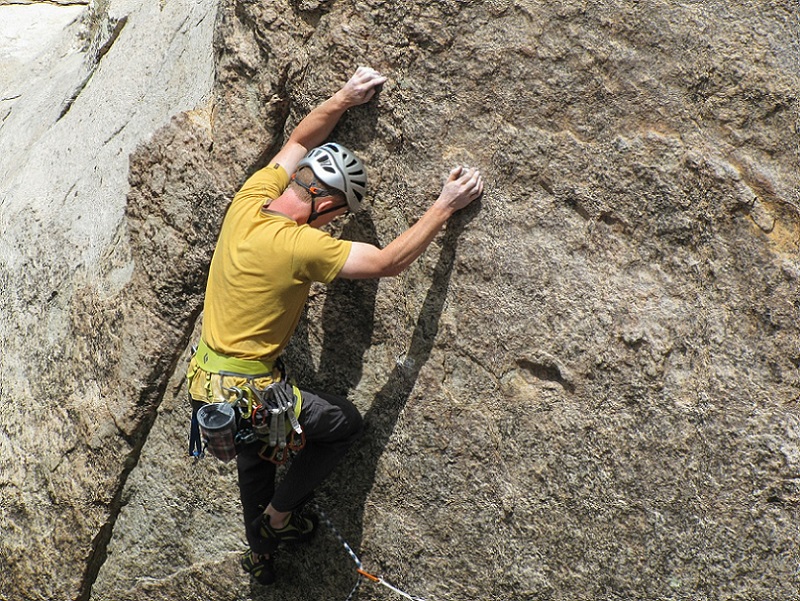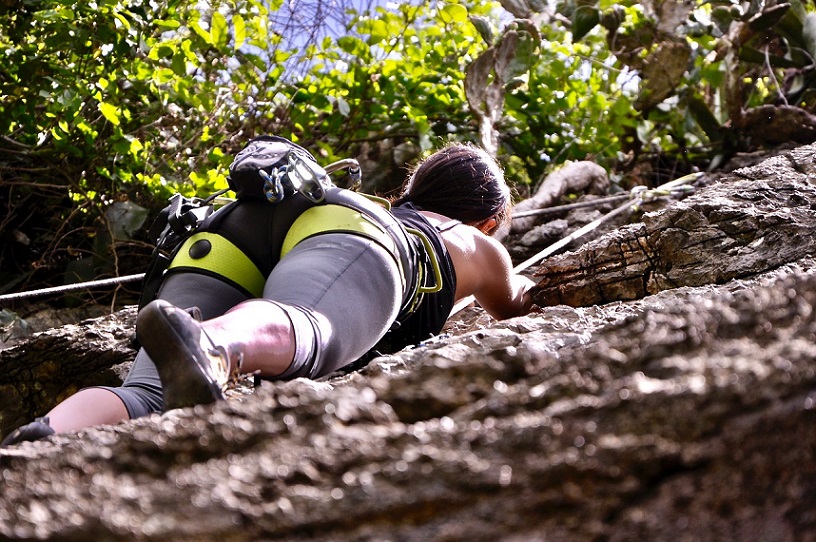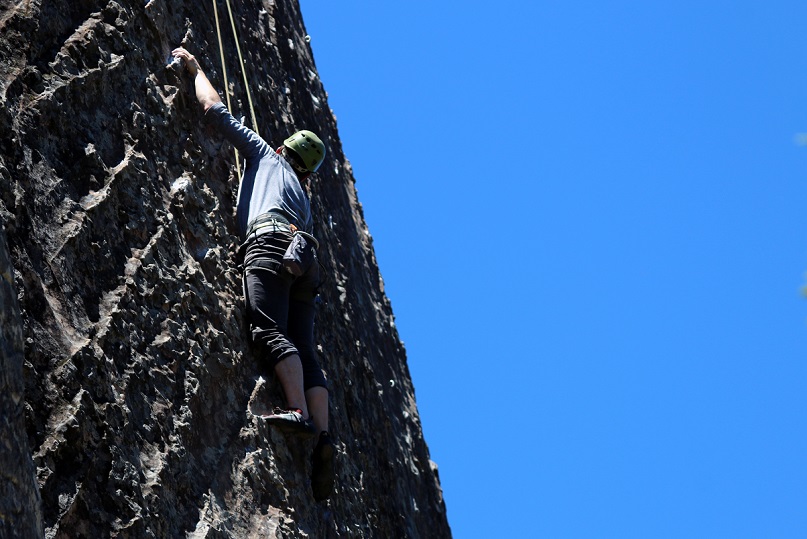It’s time to show everyone what you’ve got.
With the basics in the books, you’re feeling pretty confident about yourself. All those hours of practice have finally paid off, and you’re lead climbing with the best of them.
But that’s not enough. You’ve seen those multi-pitch climbers—and you want what they’ve got. For many climbers, multi-pitch climbing is one of the most thrilling and rewarding sports out there. Compared to other types of routes, these climbs require extensive communication, trust, and advanced skill.
Understandably, you probably still have questions about multi-pitch climbing. Namely, what techniques does it involve, and what gear does it require? In this guide, we’ll cover everything you need to know about multi-pitch climbing so you can be better prepared when the time comes.
Ready? Let’s dive in!

The Basics
What is multi-pitch climbing, exactly?
Unlike lead climbing, which involves a single climber ascending one route, multi-pitch climbing involves two climbers traversing multiple routes on the way to their destination. This type of climbing offers climbers the ability to cover longer distances and traverse more routes. In climbing jargon, each individual route is referred to as a “pitch.” Hence, multi-pitch climbing refers to the multiple routes climbers must ascend in order to complete their climb.
In order to do this, there must be one leader and one follower. The leader will ascend a pitch first, while the follower belays him from below. Once the leader has successfully reached the top of the pitch, known as a belaying station, it is time for the second climber to ascend the route.
This second ascension is what makes multi-pitch climbing unique. In order for the second climber to make it safely to the top, the lead climber must belay from above. This technique, which will be discussed in more detail later, requires skill and should not be attempted by inexperienced climbers. When the second climber makes his ascension, he must bring with him all necessary gear from below.
Once both climbers have reached the belaying station, it is time to move on to the second pitch. Some teams prefer to switch leaders at each belaying station, while some are more comfortable maintaining their roles. Ultimately, it is up to you to decide what to do, but it’s recommended that both you and your partner perform only the roles you are comfortable doing.
What You’ll Need
Now that you’ve gotten the basics down pat, let’s take a look at some of the specific gear you’ll need for multi-pitch climbing. It’s essential that you bring the right gear to avoid any discomforts or mishaps while ascending your routes. Remember that you’re not only focused on your safety during multi-pitch climbing; you’re also focusing on the safety of your partner. As such, it’s important that you keep the following tools in mind as you prep for your trip.
- Climbing Rope—In general, it’s best if you use a rope that’s longer and more durable. This means ropes with a length of 70mm and a thickness between 9.5-9.8 are considered ideal for multi-pitch climbing. These sturdier ropes are better suited for covering long distances and are more resistant to wear and tear (though they are thicker). If you’re just getting into multi-pitch climbing, consider the Mammut Infinity for trad climbing.
- Climbing Harness—It’s important you use the right harness during your multi-pitch routes. Many climbers prefer a more comfortable option when it comes to multi-pitch climbing, and harnesses such as the Metolius Safe Tech Deluxe have become popular options. With built-foam designed for maximum comfort, this harness won’t get in your way as you climb.
- Belaying Device—While we’ll talk in more detail about the type of device you’ll need later, keep in mind that you cannot accomplish multi-pitch climbing without a belayer. Belaying devices with an automated breaking system such as the GriGri have become popular for multi-pitches, as having a backup is no luxury when you’re that high up.
- Carabiners—Consider bringing around five a piece. You’ll use these carabiners for a variety of purposes from your belaying device to your anchors, so don’t worry about bringing too many.
- Guidebook—Unless you can keep the routes in your head, it’s a good idea to bring a guidebook. This will help keep you and your partner on track and safe as you switch pitches.
- Headlamp—You don’t want to be stuck in the dark on the side of a mountain. It’s recommended that both you and your partner wear a headlamp just in case it gets hard to see. This cheap one by Petzl will do the job just fine.
- Comfortable Clothes—You’ll be doing a lot of climbing, so bring something that’s comfortable. While it’s generally recommended to wear cotton clothing for lead climbing, many multi-pitch climbers find that synthetic clothes are more comfortable to cover longer routes. Whatever you choose, make sure you dress for the weather (and make sure your partner does, too).
- Shoes—You may want to consider bringing two pairs. First, you’ll need a pair of comfortable climbing shoes to wear. If you’re feeling up to it, you may also bring a light pair of approach shoes that will keep you comfortable between routes (or even while climbing).
- Quality bag—You’ll need a durable bag to keep your supplies in. Make sure the bag you bring is designed for rock climbing and doesn’t interfere with you as you move.
Keep in mind that this list is inexhaustive. When prepping for your own rock climbing trip, make sure you pack everything necessary for your safety. You’ll also want to make sure that your partner is comfortable with multi-pitch climbing. It may be tempting to go with a buddy you’ve known for a while, but it’s always better to go with someone who has experience with the unique challenges of this particular sport.
In addition, it’s imperative that you choose a partner you can trust. You and your partner will need to have excellent communication in order to climb safely. Multi-pitch climbing often involves partner signals that must be employed during the belaying process. Misunderstanding your partner’s cues could lead to accidental injury or death. As such, it’s crucial that you and your partner understand the belaying process for multi-pitch climbing.
Multi-Pitch Belaying
Understanding how and when to belay is perhaps the most important part of multi-pitch climbing. A majority of the accidents that occur in this sport occur because of miscommunications between the climber and the belayer. Keep in mind that belaying while multi-pitch climbing requires a different skillset than regular belaying.
Knowing this, let’s look at specific techniques you will need to understand in order to ensure the safety of both you and your partner.
1. Communicating that You’re “In Direct”
Once you’ve reached the top of the route, you will need to bring your partner up, as well. This is where communication becomes key.
Simply put, you won’t be able to pull your partner up if you are still on belay. This means that your partner must first take you off. Easy enough, right?
Unfortunately, many pitches are too long for simple communication. If you are close enough to your partner, shouting that you are “in direct” is good enough to do the trick.
If you are an extended distance away from your partner, however, it’s important that you have some signal in place to let your partner know you’ve made it safely to the top. Of course, you will want to rehearse the signal several times before your actual climb. If your partner mistakes some movement for the signal and takes you off belay too early, you could be in for a nasty fall.
It doesn’t matter if your system is rope tugging or pulling in a predetermined amount of rope as long as you have a system that works for you. If you are on the belaying end, never let your partner off the belay unless you are confident that you are getting the signal.
2. Pulling Your Partner up
Now you’re off belay and free to do the next step! This step requires that you pull your partner up by the rope he is tied into. This sounds easy enough on paper, but experience teaches you that it can be a regular pain.
Many climbers find it difficult to coil the rope they are pulling up. If this happens to you, try to find an area (such as a ledge) where you can comfortably coil the rope. You want to make sure that you are coiling the rope as neatly and tightly as possible to avoid hassle later on.
As a general rule, you want to make your coils increasingly smaller as you coil. This will help you maintain a tangle-free rope that can be easily brought to the next pitch. Depending on your experience with rope, it could take a few iterations to get it right.
The goal here is to pull until you’re out of rope. At some point, your partner will likely let you know that you have reached the end of the rope. When this happens, it’s time for the fun part: belaying from above.
3. Belaying from Above
Of course, in order to do this, you need to have a belaying device that can handle the technique. Luckily, both of rock climbing’s two most popular belaying devices—the Petzl GriGri and the ATC Guide—are equipped for this (Read our article: GriGri vs ATC).
Most climbers find it easiest to use the ATC when belaying from above. Keep in mind that this isn’t a universal truth. If you are more comfortable using another device, by all means, use what you know. It’s never a good idea to follow the pack and do something just because you “think” it could work out better.
When you belay your partner up, you are going to want to belay off the anchor next to you. If you are using an ATC-Guide, directly anchoring the system takes pressure away from the belayer’s body in the event of an accident and allows for auto-blocking of the rope in the event of sudden belayer incapacitation. In order to accomplish this, simply configure your Guide directly onto the anchor itself.
You also have the option of doing a redirected belay, which involves you simply locking your partner’s rope into a carabiner locked into the anchor. This is a great time to use those extra carabiners we talked about. This option is quicker to set up but will strain the anchor more and make it easier for the belay to be compromised. As such, it’s important to understand your belaying device and how to properly connect it to the anchor.
Whatever method you choose, make sure to let your partner know when you are done. This communication can be verbal or nonverbal, but you must make sure that the device is secure and that your partner is ready before you begin to belay your partner.
As with any belay, you want to pay close attention to the process until your partner has successfully completed the route. Though you will likely be fine as long as you follow the proper steps, for the safety of all involved, you never want to take your eye off the situation. This is especially true if you don’t have strong experience belaying from above.
Then What?
After you and your partner have successfully climbed the first pitch, you can take a small breather. Let it soak in. You actually did that. So smile, shout, and give each other a high five.
Once you’re done celebrating, it’s time to move on to the next pitch. Depending on what you and your partner are comfortable with, you can either switch lead climbers immediately or wait for a while. Technically, these two methods are known as “swinging leads” and “leading in blocks.”
Again, these two methods are entirely dependent on your and your partner. If one partner is more physically fit to lead climb, it makes more sense to lead in blocks. If you want to balance fatigue, it’s recommended that you swing leads.
Whatever you choose, it’s best to follow the method you and your partner have discussed and are most familiar with. Doing so can help ensure your safety and an enjoyable climb.
The Bottom Line
This guide seeks to answer everything you wish to know about the question “What is multi-pitch climbing?”
As you can see, multi-pitch climbing differs significantly from lead climbing and requires a particular skillset to pull off. In addition to unique skills such as belaying from above, multi-pitch climbing also requires that both climbers are communicative and responsive to one another.
When attempting to climb multi-pitch routes, it’s important that you and your partner know what you’re doing. Remember that it’s one thing to read a guide like this one, but it’s another thing entirely to climb routes yourself. This means that you shouldn’t attempt any route without the experienced required to do so. Never forget that the main goal of climbing is safety.
With this in mind, it’s time to hit the rocks and tackle those multi-pitch climbing like you’ve been dreaming of!






